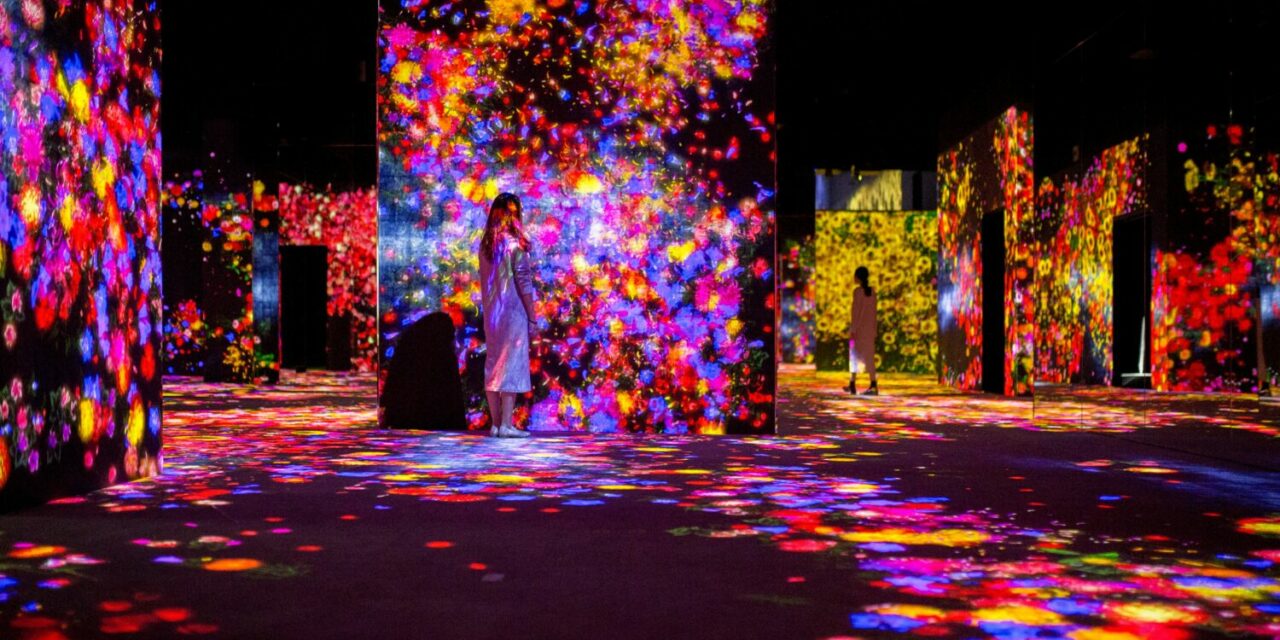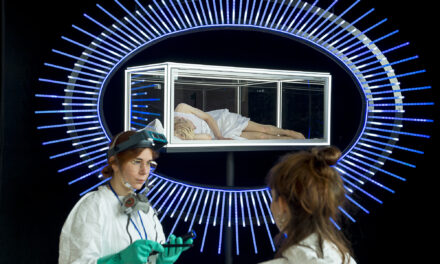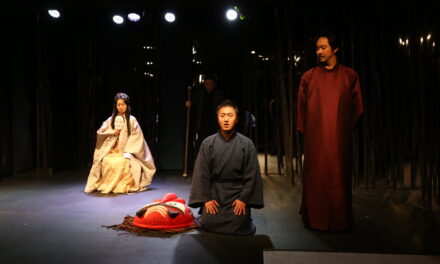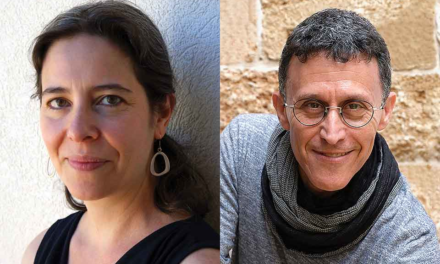teamLab, founded by Toshiyuki Inoko and several of his friends in 2001, is an art collective, an interdisciplinary group of ultratechnologists whose collaborative practice seeks to navigate the confluence of art, science, technology, design and the natural world. teamLab aims to explore a new relationship between humans and nature, and between oneself and the world through art.
Krisztina Rosner (Rosner): teamLab is an artist collective. (Even this interview is teamwork.) Instead of the idea of the single-author artist, your team is based on collaboration, with even the members’ names undisclosed on your website. What are the advantages? What are the challenges in creating this way?
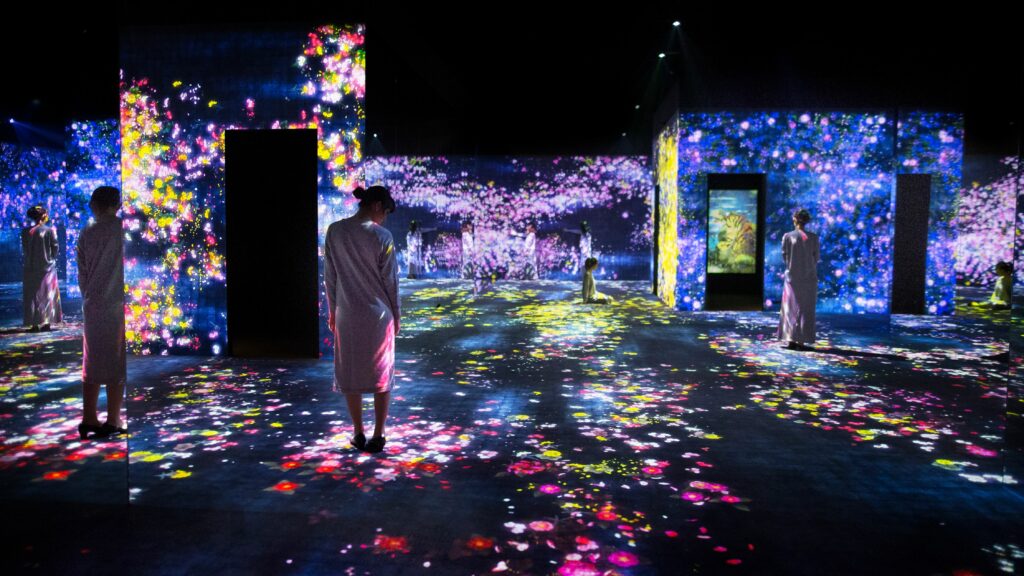
Forest of Flowers and People: Lost, Immersed and Reborn, teamLab, 2017, Interactive Digital Installation, Endless, Sound: Hideaki Takahashi
teamLab: Humans are naturally collaborative and creative. However, current education emphasizes only one correct answer over all others, stifling creativity. Free thinking and behavior that is different are suppressed. And, thus, students become afraid of making mistakes and lose their natural creativity. Whereas in the real world we find that there are no problems that have only one correct answer. Often as not, the correct answer ten years ago is now incorrect. By creating new solutions that solve problems in different ways, and giving people enjoyment in the process, new correct answers are born. It is creativity that allows us to overcome problems that cannot be defined as either correct or incorrect.
The present situation in education is that tests are taken by individuals and evaluated by the ability of the individual. Before we know it, individualism is forced upon us. Additionally, large numbers of people are addicted to smartphones. Their brains may be connected, but their body is isolated. As a result, opportunities for nurturing co-creative experiences are decreasing.
Humans learn about the world by interacting with others and by sharing experiences. People think with their bodies as they move through the world, and society has developed through creative activities born from collaboration. This is why co-creative experience is very important for society.
teamLab was founded by Toshiyuki Inoko and several of his friends, to create a “lab,” a space for co-creative activities. By putting ourselves in such an environment to create something, we wanted to deepen our thoughts and insights, simply to keep creating. Our aim is to create a new experience, and through such experience, we want to explore what the world is for humans.
Once the large concept of the artwork is set, we gather specialized members related to the work and think more finely. For example, the Flower Forest: Lost, Immersed and Reborn piece which we’ve exhibited at PACE Beijing, we’ve created with a specialist who creates 3D CG flower model and animation, a 3D software programmer, an engineer who designs equipment such as a projector, a software programmer who localizes and integrates dozens of projectors within the space, an architect and so on.
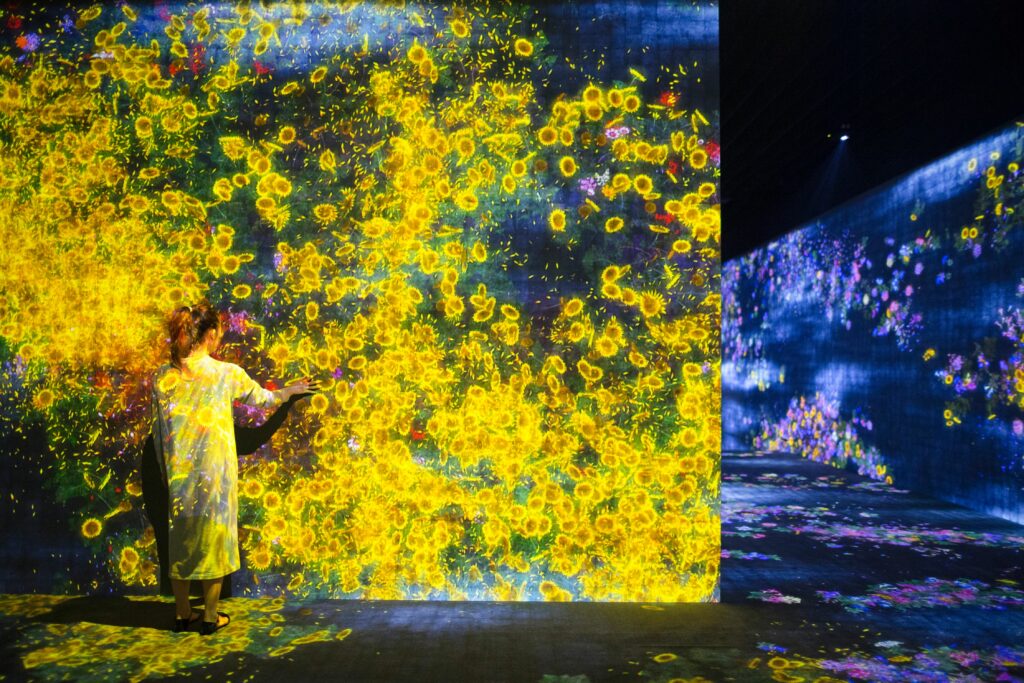
Forest of Flowers and People: Lost, Immersed and Reborn, teamLab, 2017, Interactive Digital Installation, Endless, Sound: Hideaki Takahashi
Our artworks are created by a team of hands-on experts through a continuous process of creation and thinking. Although the large concepts are always defined from the start, the project goal tends to remain unclear, so the whole team needs to create and think as they go along. teamLab’s organizational structure seems flat at a first glance, but it is also extremely multidimensional, with an underlying layer that is unclear and undecided. The big concepts are always defined from the start, and the project goal and technical feasibility also go hand in hand. This is why the goal of the artwork becomes more clearly defined as the team progresses in its work.
Our utmost interest is to keep creating as an art collective, through collective creation. We want to be with people who want to take a step into a new world. People who are creative, who want to change the world. These people we hope to inspire to have an influence on. Or having them experience our art, we want to shake their values. Rather than taking on people who don’t want to change, we’d like to continue working to inspire people who want to change.
Rosner: Last year marked the opening of the Mori Building Digital Art Museum, teamLab Borderless. Ever since its opening, the first museum dedicated to digital arts has been extremely popular, with tickets sold out for months ahead. In what ways do digital arts redefine the traditional concepts of “museum” and “exhibition”?
teamLab: teamLab believes that the digital domain can expand the capacities of art and that digital art can create new relationships between people.
Digital technology enables complex detail and freedom for a change. Before people started accepting digital technology, information and artistic expression had to be presented in some physical form. Creative expression has existed through static media for most of human history, often using physical objects such as canvases and paint. The advent of digital technology allows human expression to become free from these physical constraints, enabling it to exist independently and evolve freely. No longer limited to physical media, digital technology has made it possible for artworks to expand physically. Since digital art can easily expand, it provides us with a greater degree of autonomy within the space. We are now able to manipulate and use much larger spaces, and viewers are able to experience the artwork more directly. The characteristics of digital technology allow artworks to express the capacity for change much more freely. Viewers, in interaction with their environment, can instigate perpetual change in an artwork. Through an interactive relationship between the viewers and the artwork, viewers become an intrinsic part of that artwork.
Rosner: In the active teamLab calendar, exhibition spaces range from black-box structures through gallery venues to open-air heritage and religious sites. How these diverse spaces interact with the exhibition motifs and elements?
teamLab: We always try to utilize the unique spaces they are held in, whether those spaces are inside buildings, in public squares, or even in the middle of nature. Our interest is not the technology itself; instead, we’re trying to explore the concept of “digital” and how it can enhance the art.
Most of the Silicon Valley–originated technology is an extension of someone’s mind. Facebook, Twitter, these digital domains see the “self” as the principle. These are meant to be used personally. What teamLab wants to do is to enhance the physical space itself by digital art. It doesn’t necessarily have to be yourself that intervenes with it. It can be other people, or a group of people that vaguely includes you. And instead of a personal use, we want to make it usable by multiple people. By digitizing the space, we can indirectly change the relationships between the people inside. If the presence of others can trigger the space to change, they’d become a part of the artwork. And if that change is beautiful, the presence of others can be something beautiful as well. By connecting digital technology and art, we think the presence of others can be made more positive.
For example, one of the concepts teamLab explores is that of “Digitized Nature.”
Digital technologies such as sensing, networks, light, and sound, are non-material and have no physical impact on the environment. By using such non-material digital technologies, nature can be turned into living art, without harming it.
Nature itself becomes art.
Nature has formed over a very long period of time. By turning nature into art we can gain a sense of the continuity of nature, that humans do not usually perceive. One of our exhibitions that explores this concept is our annual summer exhibition in Mifuneyama Rakuen, in Kyushu, Japan, which we have held every summer for the past three years.
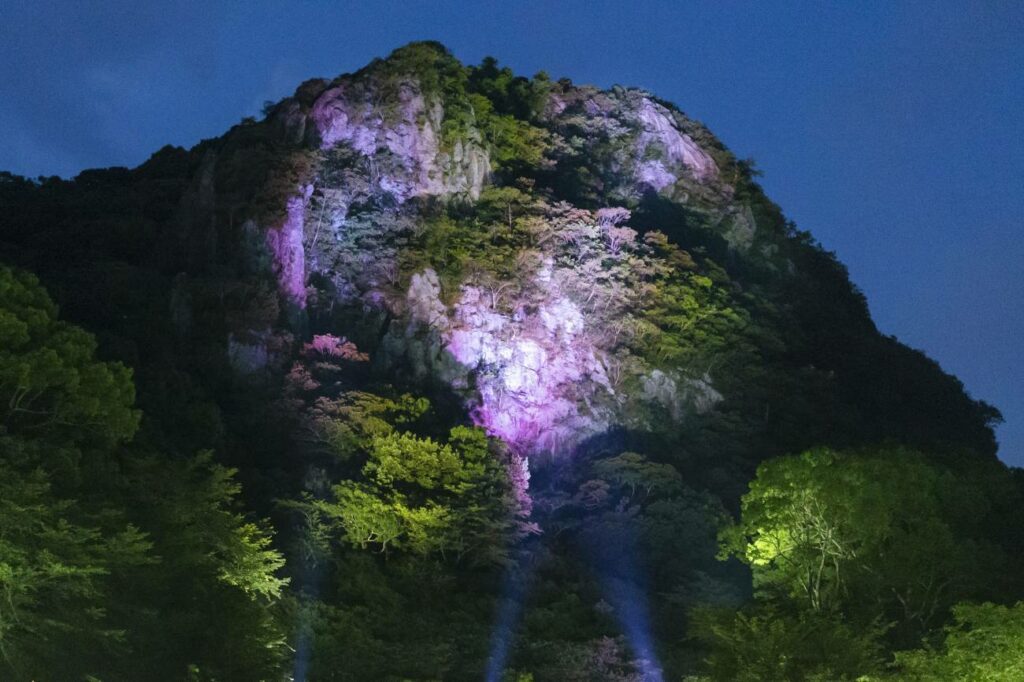
Resonating Mt. Mifuneyama, teamLab, 2018, Interactive Digitized Nature, Sound: Hideaki Takahashi
Rosner: The main concepts of teamLab, such as “borderless,” “universe,” “waterfalls,” are transitory, dynamic, outbound. In this context, how would you describe and approach the concept of home?
teamLab: teamLab is trying to transcend the boundaries between what is considered personal, such as the concept of “home,” and what can be shared with others.
Our artwork is participatory by making it interactive.
Video games, smartphones, and the internet are all interactive where you intentionally get involved in them. However, what teamLab focuses on is connecting interactiveness with art. A type of interactivity we pursue is that your presence transforms the work, whether or not you intend to do so. If you find a change caused by someone else beautiful, that someone’s presence may become beautiful as well.
This concept also applies to the cities we live in. In the city, the public, and the personal used to be completely separated. However, digital technology has made it easier to share what used to be individual. Car-sharing services such as Uber and Didi, and home-sharing services such as Airbnb and Tujia, are prominent examples of such phenomenon. By being shared by a time slot, personal belongings such as cars or homes started to play public roles like public taxis and hotels in cities.
On the other hand, by sharing the public presence in cities such as fountains and plazas via digital technology, they become personalized public things, creating a city where the public and personal ambiguously coexist. Furthermore, digital art can turn personalized public things as well as the individual inside into art, creating an art space within the city that changes according to the presence of people. This dissolves the feeling of discomfort among others, allowing more people to experience the beauty of art, hence turning the personalized things public again.
Rosner: Speaking of home: even though your office is based in Tokyo, teamLab is well-known globally. Recently your exhibition Au-delà des limites (Borderless) was a part of “Japonismes 2018,” the official program representing Japanese art in France. How do you see your role in the context of the contemporary Japanese art scene?
teamLab: We do not know what our role is in the context of the contemporary Japanese art scene.
We think that the digital era has enabled art to expand. We describe our work as interactive digital art that changes the relationships between the people within it and the way that people experience art. Viewers and the environment take on a crucial role in defining and changing interactive artworks. The viewer is an active participant and ultimately becomes a part of the artwork. The boundaries between artwork and viewer become ambiguous. Unlike a viewer who stands in front of a conventional painting, a viewer immersed in an interactive artwork is more aware of other people’s presence.
Digital technology has opened up new creative possibilities. It has also allowed us to take a scientific approach in exploring the logical constructs of ancient Japanese spatial theory. By using the logical construction of what we have termed ultrasubjective space, we can experiment with new visual experiences in our art. We are challenging contemporary human perceptions of the world.
The human race has progressed over many years on earth. We believe, however, that along the way members of modern society have forgotten how they once saw the world. By reaching back and examining past means of perception, we find hints for the future.
Rosner: One of teamLab’s trademarks is the visitors’ “immersive” and “ultrasubjective” experience, with the key message “making the presence of others a positive experience.”[1] In what ways is teamLab engaged in social changes?
teamLab: One characteristic of interactive art is that the existence and behavior of the viewer can influence the art, thereby blurring the line between art and viewer. In other words, the artistic work is made up of both the art and the viewer. One consequence of this is a shift in the relationship between art and viewer as well as between the individual viewer and the group. Factors such as whether there were any viewers that saw the work five minutes before you did, or what the viewer next to you is currently doing, suddenly become important. At a minimum, our interactive installations call more attention to the actions of the viewers around you than would a traditional painting. The result is that the art gains the ability to influence the relationships between the viewers standing in front of it. And if the effect of another person’s presence on the art is beautiful, it is possible that that person’s presence itself will be seen as beautiful.
The paradigm in traditional art has been to treat the existence of other viewers as a nuisance. If you are at an exhibition with no other viewers, for example, you are likely to think of yourself as extremely lucky. But in the exhibitions put together by teamLab, we encourage people to think of the presence of other viewers as a positive factor.
The importance of this shift in thinking stretches beyond the art world. In modern cities, the presence of other people around us, as well as their unpredictable and uncontrollable behavior, is often seen as an inconvenience to be endured. This is because the presence of each person and those in their vicinity do not have a visible effect on the city. If entire cities were to be wrapped in the type of digital art conceived of by teamLab, we believe that people would begin to see the presence of other residents in a more positive light.
At some point in history, humans saw flowers and thought “beautiful.” But we do not really understand this phenomenon of “beauty.” Evolution explains some instances: it is natural that we would perceive other humans to be “beautiful” from a reproductive standpoint. But this does not explain why humans have found flowers “beautiful.” In the time of ancient humans, people did not see beauty in something as insignificant as flowers. In other words, we humans attributed the same idea of “beautiful” to targets for reproduction as well as to unrelated things like flowers. In theory, we should have used different words for these two completely unrelated concepts, so the fact that we conceive of them, in the same way, is quite miraculous.
We believe that art is an act of modern people creating their own flowers and expanding the notion of “beautiful” with those flowers, just in the way that ancient human beings saw flowers as “beautiful” and expanded the idea of beauty. We do not instantly understand the reasons or meaning behind this expansion. However, through these positive expansions of “beautiful,” thirty or fifty years later, people may behave differently in a way that we cannot understand with today’s limited knowledge, allowing humanity to continue to grow and thrive.
Rosner: Especially in the twentieth and twenty-first centuries, the art collectives in performing and visual arts often emphasize that art is (and should be) a political act. How do you think about the connection between art and politics in the recent global political environment?
teamLab: When we look at the world through an intellectual lens, the world is filled with problems. And when you see the problems that we cannot solve, you just feel hopeless. In this era, we think what’s more important, at least as an artist, is seeking out and affirming an idealistic part of humanity, and presenting an idea of the future. We’re not talking about a simple fiction of manga or video games but, instead, an ideal fictitious world that may be realized somewhat. There are problems that cannot be solved at this very moment. But what we can do is to suggest that we may be able to create an ideal world once more by connecting the hints that can be found in the long history of humanity. We just find it more important to create the world than to criticize the world.
Rosner: One of the major paradigms of contemporary arts, humanities, and social studies is the “nonhuman turn,” attempting to describe ways the human has coexisted, collaborated with, the nonhuman. In a previous interview[2] you concluded: “Eventually, we would like to release humans from substances.” Would you elaborate a bit further on this?
teamLab: The digital has liberated human expression from the physical. Expression no longer requires an irreversible bond to the material in order to exist. As we immerse and meld ourselves into the work with others, we explore a continuity among people, as well as a new relationship that transcends the boundaries between people and the world.
We want to create an experience where the relationship between the world and yourself is borderless and continuous. There is no such thing as a perfect boundary between people; rather, it is more ambiguous and relating, even if the person is unrelated to you.
We want people to be involved with the world. As much as possible, we want to rethink the boundary between the world and oneself. Living in the city, you feel as if there is a border between yourself and the world, but the world really is meant for us to be involved with. It may be just a bit, but the world is something that changes due to your existence. We believe that there is a borderless, continuous relationship between us and the world. We dissolve the boundaries between the artworks. They transcend, relate, and intermix. By experiencing that, you might think that everything in this world may be borderless, and that the world without boundaries is beautiful. By people experiencing the beauty of the borderless world, and by knowing that having no boundary is beautiful, their standard of beauty may get inspired. This still won’t solve tomorrow’s problems, but after ten or fifty years, we think people’s behavior may change unconsciously little by little due to their new standard of beauty. That is what we are hoping to do.
Rosner: In theatre and performing arts, there is a renewed interest in New Media Dramaturgy, in the role of digital, projected images, lights, the dynamic transitions between installation, performance, and theatre. In a collaboration between teamLab and a director or group to devise theatre, what kind of work are you interested in creating? Traditional? Contemporary?

Credit (for that artwork): KABUKI Spectacle at FOUNTAINS OF BELLAGIO Koi-Tsukami “Fight with a Carp”, teamlab, 2015
teamLab: We collaborated with kabuki (Japanese theatre) star Somegoro Ichikawa in 2015 to create the Kabuki Spectacle: Koi Tsukami (Fight With A Carp) at the famed Bellagio hotel in Las Vegas. teamLab handled the production of the show’s visual effects. Using the Bellagio’s 300-meter-wide, 18-meter-high array of fountains as a giant water screen, we expanded the stage space and projected giant holograms of a huge carp and images of the four seasons. By projecting images rendered with light against the backdrop of a traditional kabuki stage, kabuki’s trademark whirlwind changes in setting and scenery were given a new form through digital technology. By projecting images directly onto a back panel situated on a special stage, the kabuki’s famous mie poses and bukkaeri (quick changes) were fantastically presented in a way possible only through digital technology. For a scene where actor Somegoro Ichikawa grappled with a giant carp, the otherworldly fish lept off the stage to swim about in a 300-meter space—a dynamic effect made possible through seamless integration of the water screen with the stage.
When collaborating, it is important to us whether our collaborators also seek to manifest social change through digital art. We welcome collaboration with any group that wishes to improve the lives of people with immersive installations.
What is most important to us is collaborating with people who envision the same kind of future as we do.
Rosner: teamLab was founded seventeen years ago. Looking back at the first period, what are the major changes since then, in terms of concept and technology?
teamLab: teamLab was creating digital art from the beginning. Our aim has always been to change people’s standards of value and contribute to societal progress. That hasn’t changed since the very start.
However, we had neither the opportunities to present them, nor could we imagine how to economically sustain our teams producing art. On the other hand, we believed in the power of digital technology and creativity, and we simply loved it. We just wanted to keep creating something new, no matter which genre it would turn out to be. And while we took part in various projects to maintain teamLab, we’ve increased the number of technologists such as architects, CG animators, painters, mathematicians, and hardware engineers.
As time went on, while we gained passionate followers among young people, we were still ignored by the Japanese art world. Our debut finally came in 2011 at the Kaikai Kiki gallery in Taipei, thanks to the artist Takashi Murakami. Since then, we have gained opportunities in cosmopolitan cities such as Singapore, where we joined the Singapore Biennale in 2013. Also in 2014, New York PACE Gallery has started to help promoting our artworks. These fortunate factors allowed us to expand rapidly. And finally in 2015, for the first time in Japan, we were able to organize our own exhibition. These situations further accelerated our evolution and gave us opportunities to exhibit internationally; London, Paris, the US, Taiwan, China, Korea, Indonesia, Thailand, and so on.
Rosner: The list of your upcoming exhibition is impressive, ranging from Crystal Fireworks to Water Particles, with locations between Japan, China, and the US. Where is teamLab heading? What are the new objectives and challenges?
teamLab: One of our major upcoming exhibitions this year is called teamLab: Universe Of Water Particles In The Tank, and it will take place in a former oil tank at Tank Shanghai. This exhibition will feature a waterfall that cascades down the interior of the Tank that interacts both with viewers and with another flower artwork, thus creating another space that transcends the boundaries between artwork and viewer and between artworks and each other.
We want to create an experience that turns the existence of unrelated others into something positive.
We want to create an experience where the relationship between the world and the self is borderless and continuous. There is no perfect boundary between people; rather, it is more ambiguous and interconnected, even if the other person is unrelated to you.
In all of our exhibitions, we hope to dissolve the boundaries between people and artworks, between artworks and each other, and between the self and the world, allowing them to transcend, relate, and intermix. By experiencing that, one might think that everything in this world is borderless and that the world without boundaries is beautiful.
That is what we are hoping to keep doing.
Notes
[1] https://www.teamlab.art/concept/Relationships/ (2019.01.19).
[2] https://www.studiointernational.com/index.php/toshiyuki-inoko-teamlab-interview-transcending-boundaries (2019.01.19).
This post was written by the author in their personal capacity.The opinions expressed in this article are the author’s own and do not reflect the view of The Theatre Times, their staff or collaborators.
This post was written by Krisztina Rosner.
The views expressed here belong to the author and do not necessarily reflect our views and opinions.

